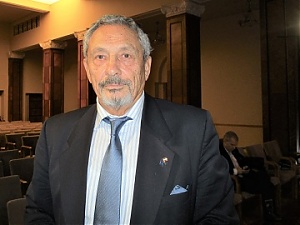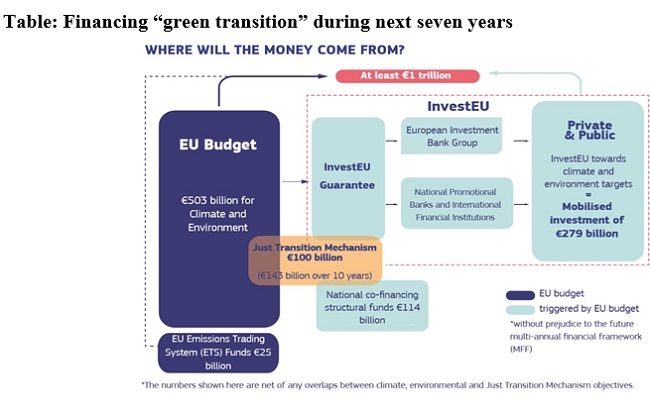Analytics, Energy, EU – Baltic States, Financial Services, Investments, Modern EU
International Internet Magazine. Baltic States news & analytics
Tuesday, 16.12.2025, 12:44
EU’s “green deal”: investment and financial facilities for the states
 Print version
Print version |
|---|
In any strategy there are some main ingredients for
transforming it into a success story: the narrative
(in our case, the “green deal”, which is based on the EU leaders’ agreement on
carbon neutrality by 2050), the instruments
(necessary regulations and directives concerning new farming rules, use of
pesticides, environment quality standards, fisheries, product safety, as well
as fiscal, tax and social issues) and the financial
resources.
In December 2019, the Commission presented the European
Green Deal*), with the ambition of becoming the first climate-neutral bloc in
the world by 2050. Europe's transition to a sustainable economy means significant
investment efforts across all sectors: reaching the current 2030 climate and
energy targets will require additional investments of €260 billion a year by
2030.
The success of the European Green Deal Investment Plan will
depend on the engagement of all actors involved. It is vital that the member states
and the European Parliament maintain the high ambition of the Commission
proposal during the negotiations on the upcoming financial framework. Hence, a swift
adoption of the proposal for a transition fund regulation will be crucial.
*) More on the “green deal” in the BC’s publications (see
the list below +); the main reference in: https://ec.europa.eu/info/publications/communication-european-green-deal_en
The Commission will closely monitor and evaluate the progress
on this transition path. As part of these efforts, every year the Commission will
hold a Sustainable Investment Summit, involving all relevant stakeholders
and it will continue to work for promoting and financing the transition. The
Commission invites the member states’ investment community and authorities to
make full use of the enabling regulatory conditions and ever-growing needs for
sustainable investments, taking an active role in identifying and promoting
such investments.
Main EGDIP’s objectives
According to the Commission’s proposals, the EGDIP has three
main objectives:
a) increasing funding for “green transition” and mobilizing at
least €1 trillion to support sustainable investments over the next decade
through the EU budget and associated instruments, in particular InvestEU;
b) creating “an enabling framework” for private investors
and the public sector to facilitate sustainable investments; and
c) providing support to public administrations and project
promoters in identifying, structuring and executing sustainable projects.
The European Green Deal Investment Plan, EGDIP (often called
Sustainable Europe Investment Plan, SEIP), is the EU’s “green deal” investment
pillar. The ultimate goal is to mobilize at least €1 trillion in sustainable
investments over the next decade. Part of the plan, the Just Transition
Mechanism, will be targeted to a fair and just green transition. The latter is
expected to mobilize at least €100 billion in investments during 2021-27 to
support workers and citizens in EU’s regions most affected by the “green transition”
process (see the table below).
More on the “green deal” investment plan in: https://ec.europa.eu/commission/presscorner/detail/en/qanda_20_24

As soon as the EU budget alone cannot be sufficient and
enough in tackle climate change and meeting “green transition” measures, the
investment needs will be also covered by the member states’ budgets and active private
sector.
Source: https://ec.europa.eu/commission/presscorner/detail/en/qanda_20_24
EIB’s loan facilities
The EIB’s loan facility will target mostly those EU regions
that would be most affected by the green transition. The exact geographical
coverage will be the same as under the InvestEU “just transition scheme”, i.e. supporting
projects in those regions which have approved transition plans as well as the projects
directly benefiting such regions.
Investment facilities will cover energy supply and transport
infrastructure, district heating networks, energy efficiency measures including
renovation of buildings and other spheres of “social infrastructure”, to name a
few.
The support under the public sector loan facility benefits
projects which do not generate revenue and would otherwise not get financed. It
will therefore be complementary to the products offered by the InvestEU
dedicated just transition scheme.
The EIB will contribute to a public sector loan facility to
support national and regional authorities with low-interest loans. With the
contribution from the EU budget of €1.5 billion and the EIB lending of €10 billion
at its own risk, the public sector loan facility could mobilise about €25-30
billion of public investments during 2021-27. It will be used for investments
in energy and transport infrastructure, district heating networks, renovation
and insulation of buildings, etc. The Commission expects to finalise a draft
for setting up a new public sector loan facility in March 2020.
Other EU financial instruments:”just transition”
The transition mechanism inspired and financed by the EU
institutions will consist of three main sources of financing:
1) A transition fund, with about €7.5
billion from the EU funds (expected to come from the additional part of the
next long-term EU budget). In order to qualify for the fund’s support, the
member states, in consultation with the Commission, have to identify the
eligible “transitional territories” and economic sectors. These resources have
to be “coordinated” with the financial support from the European Regional
Development Fund and the European Social Fund Plus. In sum, this will provide about
€30-50 billion of funding guarantees, which will mobilise even more
investments. The fund will primarily provide grants to regions in the states to
support, for example, vocational training for workers to develop skills and
competences for the sustainable growth market, perspective SMEs, start-ups and
incubators to create new economic opportunities in these regions. It will also
support investments in the clean energy transition, for example in energy
efficiency and transportation.
Reference: https://ec.europa.eu/commission/presscorner/detail/en/fs_20_39
2) A dedicated transition scheme under
InvestEU to mobilise up to €45 billion of investments. It will seek to
attract private investments, including in sustainable energy and transport that
benefit those regions and help their economies find new sources of
growth.
3) A public sector loan facility with the
European Investment Bank backed by the EU budget to mobilise between €25
and €30 billion of investments. It will be used for loans to the public sector,
e.g. for investments in district heating networks and renovation of buildings. These
two directions are of paramount importance for the housing and construction
market in the Baltic States. The Commission will come with a legislative
proposal to set this up in March 2020.
Advantages for the Baltic States
However, these “transition mechanism” concept is more than
funding and financial resources: relying on a transition platform, the
Commission will be providing advises and technical assistance to the EU states
and investors and make sure the affected communities, local authorities, social
partners and non-governmental organisations are involved.
Thus, the transition mechanism will include a strong
governance framework centered on regional and territorial “green transition”
plans.
In the “transition mechanism”, the following advantages are
expected for the member states: - supporting transition to low-carbon and
climate-resilient activities; - creating new jobs in the green economy’s
sectors; - investing in public and private sustainable transport; - providing
technical assistance in sustainability; - investing in renewable energy
sources; - improving digital connectivity; - providing affordable loans to
local public authorities; - improving energy infrastructure, including district
heating and transportation networks.
More in the Commission Communication on “green deal” (Annex
on the road map and key actions): https://ec.europa.eu/info/sites/info/files/european-green-deal-communication-annex-roadmap_en.pdf.
General information in the following web-links:
- MEMO: The European Green Deal Investment Plan
and the Just Transition Mechanism explained; = Factsheets: Investing
in a Climate-Neutral and Circular Economy; The Just
Transition Mechanism: Making sure no one is left behind, and EU-funded
projects to green the economy;
- Commission
Communication on the Sustainable Europe Investment Plan;
- Proposal
for a regulation establishing the Just Transition Fund;
- Amendments
to the Common Provisions Regulation;
+) BC’s list of
publications on “green deal”:
- Green
Deals’ final approval: great days for Europe. 13.12.2019. In: http://www.baltic-course.com/eng2/modern_eu/?doc=153069
and http://www.baltic-course.com/eng2/modern_eu/?doc=153093;
- Energy
efficiency issues in the construction sector. 02.01.2020. In: http://www.baltic-course.com/eng2/modern_eu/?doc=153285;
- Energy policy and
“green deal”: the EU and Baltic’s perspectives. 06.12.2019. In:
http://www.baltic-course.com/eng2/modern_eu/?doc=152950;
- “Green
financing”: creating durable, effective and sustainable solution. 19.12.2019.
In:
http://www.baltic-course.com/eng2/modern_eu/?doc=153170
- 28.01.2022 BONO aims at a billion!
- 26.08.2021 LLC Dizozols Investments finalizes investment attraction deal with Crowdestor with record-high profits
- 25.01.2021 Как банкиры 90-х делили «золотую милю» в Юрмале
- 30.12.2020 Hotels showing strong interest in providing self-isolation service
- 30.12.2020 EU to buy additional 100 mln doses of coronavirus vaccine
- 30.12.2020 ЕС закупит 100 млн. дополнительных доз вакцины Biontech и Pfizer
- 29.12.2020 В Латвии вводят комендантский час, ЧС продлена до 7 февраля
- 29.12.2020 В Rietumu и в этот раз создали особые праздничные открытки и календари 2021
- 29.12.2020 Latvia to impose curfew, state of emergency to be extended until February 7
- 29.12.2020 Linde Gas открывает завод в Кедайняйской СЭЗ








 «The Baltic Course» Is Sold and Stays in Business!
«The Baltic Course» Is Sold and Stays in Business!

